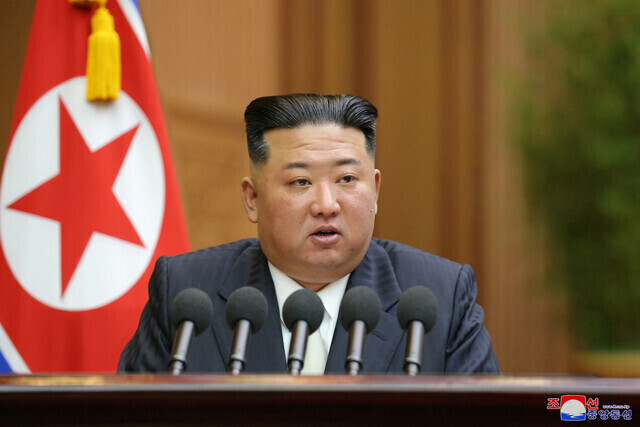hankyoreh
Links to other country sites 다른 나라 사이트 링크
Once war deterrents, are N. Korea’s nukes now meant for preemptive use?

Since the collapse of its February 2019 summit with the US in Hanoi, North Korea has been working to develop new tactical guided weapons with improved interception avoidance capabilities and strike accuracy.
More specifically, it has been test-launching submarine-launched ballistic missiles (SLBMs) and new short-range ballistic missiles that are difficult to intercept due to their irregular up-and-down movements, including the “North Korean Iskander” (KN-23), “North Korean tactical surface-to-surface missile ATACMS” (KN-24), and “super-large multiple rocket launcher” (KN-25).
These weapons are capable of carrying tactical nuclear warheads. After focusing in the past on “retaliatory deterrence” with the development of ICBMs capable of striking the continental US, it is now working steadily to develop tactical nuclear capabilities targeting the South.
When North Korea adopted its “nuclear armament policy law” on Sept. 8, many news outlets reported that its nuclear capabilities had gone from being a deterrent against the US to a means of launching a preemptive strike on South Korea.
The move was interpreted as codifying a doctrine of “preemptive nuclear strikes” by stipulating that Pyongyang could use nuclear weapons preemptively even in cases of non-nuclear strikes against it.
In this law, the North’s list of five conditions for the use of nuclear weapons sparked widespread concerns over the arbitrary, aggressive, and radical nature of its nuclear doctrine. Some said that the lowering of the threshold for nuclear weapon use to include cases where a nuclear weapon or other WMD attack has either been carried out or is deemed to be imminent raises the risk of a nuclear war erupting due to a misjudgment or accident.
Other analysts said that with its nuclear armament policy law, Pyongyang was explicitly stating conditions of use and command and control areas to shore up its nuclear war-fighting capability so that it can use its nuclear weapons to achieve victory in an actual warfare situation. This analysis was bolstered when leader Kim Jong-un reviewed the combat operation postures of different nuclear warhead delivery methods during exercises of the North Korean military’s tactical nuclear weapon and long-range artillery units between Sept. 25 and Oct. 9.
In contrast, others insist that the nuclear armament policy should be viewed as part of a larger deterrence strategy. Under this view, Pyongyang’s basic aim is to deter war, but if that deterrent fails, it intends to use nuclear weapons to perform an “operational mission” to ensure a decisive victory.
“North Korea’s legislation and declaration of its nuclear doctrine are intended to establish a sure nuclear deterrent and prevent unnecessary misunderstandings and crisis escalation by announcing when, under what conditions, and in what ways nuclear weapons would be used,” suggested Kim Jung-sup, a former Ministry of National Defense planning and coordination office director who currently serves as vice president of the Sejong Institute.
“The nuclear doctrine, which states that nuclear weapons can be used preemptively against non-nuclear attacks, has always been adopted by nuclear powers that share borders with adversaries and are at a disadvantage in terms of conventional military capabilities,” he added.
“This has been the nuclear doctrine of NATO during the Cold War era, Russia since the end of the Cold War, and Pakistan in its conflict with India,” he said.
Based on this analysis, the North’s nuclear doctrine is not as unusual or “radical” as many believe, but is an approach drawn from historical experience and the universal logic of nuclear deterrence that has taken shape since the Cold War era.
By Kwon Hyuk-chul, staff reporter
Please direct questions or comments to [english@hani.co.kr]

Editorial・opinion
![[Column] The state is back — but is it in business? [Column] The state is back — but is it in business?](https://flexible.img.hani.co.kr/flexible/normal/500/300/imgdb/original/2024/0506/8217149564092725.jpg) [Column] The state is back — but is it in business?
[Column] The state is back — but is it in business?![[Column] Life on our Trisolaris [Column] Life on our Trisolaris](https://flexible.img.hani.co.kr/flexible/normal/500/300/imgdb/original/2024/0505/4817148682278544.jpg) [Column] Life on our Trisolaris
[Column] Life on our Trisolaris- [Editorial] Penalties for airing allegations against Korea’s first lady endanger free press
- [Editorial] Yoon must halt procurement of SM-3 interceptor missiles
- [Guest essay] Maybe Korea’s rapid population decline is an opportunity, not a crisis
- [Column] Can Yoon steer diplomacy with Russia, China back on track?
- [Column] Season 2 of special prosecutor probe may be coming to Korea soon
- [Column] Park Geun-hye déjà vu in Yoon Suk-yeol
- [Editorial] New weight of N. Korea’s nuclear threats makes dialogue all the more urgent
- [Guest essay] The real reason Korea’s new right wants to dub Rhee a founding father
Most viewed articles
- 1[Column] Why Korea’s hard right is fated to lose
- 2Amid US-China clash, Korea must remember its failures in the 19th century, advises scholar
- 3[Column] The state is back — but is it in business?
- 4[Column] Life on our Trisolaris
- 5[Guest essay] Maybe Korea’s rapid population decline is an opportunity, not a crisis
- 6OECD upgrades Korea’s growth forecast from 2.2% to 2.6%
- 7AI is catching up with humans at a ‘shocking’ rate
- 8[Column] Can Yoon steer diplomacy with Russia, China back on track?
- 9[Editorial] Yoon must halt procurement of SM-3 interceptor missiles
- 1060% of young Koreans see no need to have kids after marriage